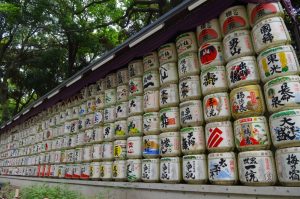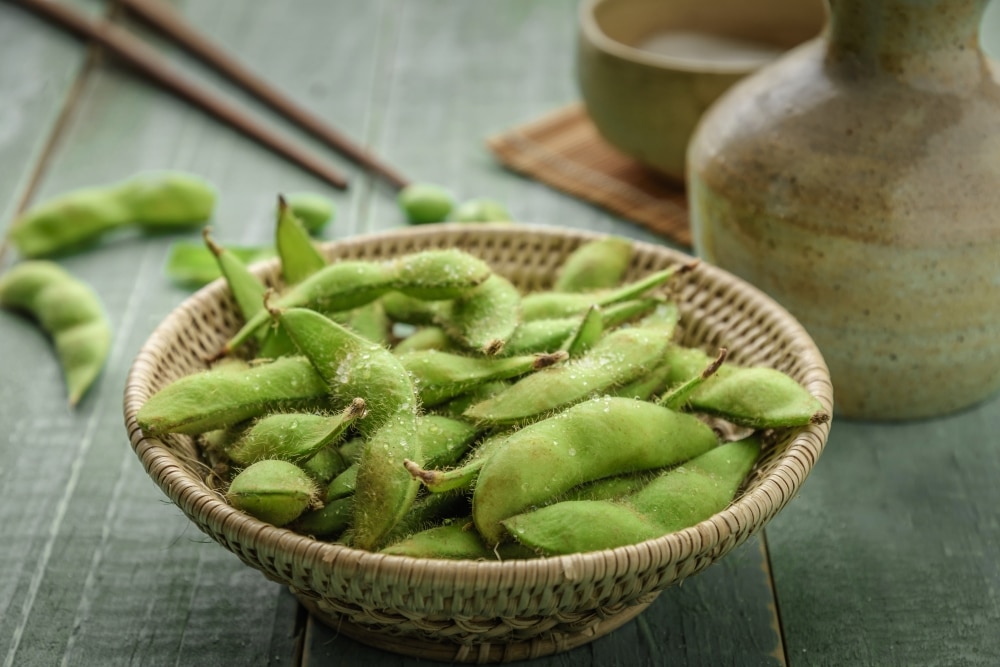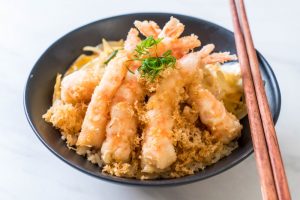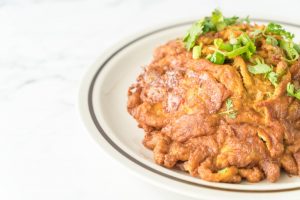By the very nature of the Japanese archipelago, which is made up of many islands and stretches for more than 3,500 kilometers, Japanese cuisine is first and foremost a regional (or even local) cuisine, in which certain major principles are expressed in accordance with the local tastes and ingredients available. The result is a wide variety of dishes; however, these kitchens have gradually been marked both by common changes in consumption patterns across the country and by foreign innovations (new ingredients, new culinary techniques) quickly accepted, disseminated and adapted throughout the country.
History of Japanese Cuisine in details:
Jōmon Period (-14000 – -400 BCE)
The Jōmon period corresponds to the Japanese protohistory. During this period, food in Japan has gradually evolved from the traditional diet of nomadic hunter-gatherers to that of sedentary peoples mastering agriculture and cooking.
In prehistoric Japan, the Jōmon people living in Japan were mainly semi-sedentary hunter-gatherers. The Jōmon islands have a great diversity of Natural Resources in all the biotopes of their archipelago : in spring and early summer, deep-sea fish species (Tunas and bonitos) and marine mammals are fished as they approach the coast to breed. Salmon and other marine species brought back by the Oyashio current are also caught. On the shores of the Sea of Japan and the Pacific, there are numerous shellfish aggregations that show the strong presence of shellfish in the diet. During this period, the most practiced ways of getting food were river fishing and hunting.
In the late fall and throughout the winter, deer and wild boar are hunted, as are bear, deer and Hare. Many local tree species provide large amounts of food for humans and animals. In autumn, the fruits and seeds are ready to be picked, and the harvest of chestnuts, nuts, hazelnuts and Acorns is stored in many underground silos.
Yams and other wild plants supplement the diet. Although agricultural techniques have not yet been certified, there has been a gradual development in the cultivation of certain types of plants, such as squash, hazelnut and millet.
There is evidence that soybeans were already present in Japan and probably cultivated during the Jōmon period, with significant variations in seed size indicating human hand selection, probably in multiple locations in Korea, China, and Japan before 5000 BCE, and in large amounts from around 3000 BCE.
The first proof of cooking comes from the pottery. They were mostly quite small bowls with a round bottom of 10-50 cm high used to boil food and store it. Some date back to the 14th millennium BC..
The first jōmon pottery can be found throughout the archipelago ; archaeologists count 70 different styles and even more sub-styles. Although the first pottery was small in size so that it could be transported easily, the size of the pieces of pottery gradually increased and their style diversified, reflecting the gradual sedentarization of these people.
After 1500, the climate was cooling and the population was drastically reduced. Compared to the previous period, few sites prove a human presence after 1500. From 900 B. C., new arrivals from the Korean Peninsula settled in Western Kyūshū. These new populations bring with them new techniques and new ingredients: they bring rice cultivation and master bronze, iron and pottery similar to that of Mumun culture. For a thousand years, both populations coexisted.
Yayoi Period ( 400 BCE – 250 AD)
During this period, in addition to rice cultivation, the Japanese also cultivated wheat, barley, millet, buckwheat and soybeans. The food is described for the first time: raw vegetables, rice, fish tasted without utensils. Alcohol is consumed at parties, and the first known Japanese chef appears.
The earliest writings about Japan are Chinese writings from this period. WA – the Japanese pronunciation of one of the first Chinese names given to Japan-is for the first time mentioned in 57 AD. Ancient Chinese historians described Wa as a country dotted with hundreds of tribal communities, not the unified land declared in the Nihonji that gives Japan a founding date of 660 BC.
Chinese sources from the 3rd Century report that the people of Wa lived on raw vegetables, rice and fish served on wooden and bamboo platters (takatsuki), that they had granaries and provincial markets, and ate with their hands, baguettes not yet being present.
In a history written in Kojiki, Takahashi ujibumi, and Nihon shoki, Emperor Keikō named Iwakamutsukari no Mikoto, chief of the imperial court, having greatly appreciated a dish combining bonito and Palourde. Today, he is considered the founder of Japanese seasoning culture. At that time, which preceded the appearance of the soy sauce, the seasoning consisted mainly of salt and vinegar.
The first mention of alcohol consumption in Japan appears in Wei’s book, chronicles of the Three Kingdoms. This text from the third century describes Japanese drinking and dancing.
According to some, the production of rice sake was introduced from China to Japan shortly after rice cultivation, spreading from West to east from Kyūshū and Kinki.
The inoculation of ferment was of the most primitive, so-called kuchikami ( “chewed in the mouth”), the cooked cereals being saccharified by saliva, and the making of sake was said to be kamosu, derived from the verb kamu (“chew”, “bite”) . However, the advent of sake-making methods such as those that persist today will not take place until the 12th century. The confirmation of the presence of sake can be found in Kojiki, the first Japanese history, which was made in the year 712 AD.
The Yamato Period (250-710 AD)
The Yamato period was the scene of many Korean and Chinese migrations, introducing Confucianism and Buddhism, which triggered the first decree banning meat consumption. Traditional ingredients such as soy sauce come from trade with neighbouring nations ; sake is becoming more common. There is little information on the culinary practices of this period. It should be noted, however, that strong waves of Chinese (in the fifth century) and Korean (in the fourth century) immigration may have had a significant impact.
The introduction of Buddhism in Japan was attributed to King Baekje Seong in year 538. The Soga clan, a family of the court that accompanied the rise of the Emperor Kinmei around 531 AD, pushed for the adoption of Buddhism and a Chinese Confucian cultural model, but encountered strong opposition from the Nakatomi clan, who was responsible for shinto rituals at the court, as well as from the Mononobe clan.
For more than a century, wars of influence have taken place to fight Buddhism. However, in 675 AD, the use of cattle and the consumption of wild animals (horse, cow, dog, monkey, Birds, etc.) was banned by the Emperor Temmu to respect the rules of buddhism. Consumption of pests, fallow deer and wild boar was not prohibited. This ban was renewed throughout the Asuka period, but ended in the Heian period. One can see in this prohibition the beginnings of the shojin ryori, which was not widespread until the 13th century.
Sake, made of rice, water, and Kōji mould (Tar, Aspergillus oryzae), of very low degree, became the predominant alcohol. The soy sauce, originally from China, originated from a paste called hishio, first made with meat and fish marinade, then with soybean seeds and flour. It was introduced to Japan during the Fujiwara period (694-710).
Traditional Cuisine
Japanese cuisine can be defined strictly as the traditional Japanese cuisine, called nihon ryōri (փփփ or washoku) preceding the Meiji Era, which saw the introduction of recipes and cooking techniques from abroad.
Nara Period (710 AD -794 AD)
The Nara era brought many changes : the mastery of fermentation increased, and ingredients such as bread and natto were introduced. Seasonings previously reduced to vinegar and salt were superseded by the ancestors of the classic seasonings miso, hishio (the ancestor of soy sauce), and shi.
Fermentation is an essential process for the preparation of many ingredients in japanese cuisine (to name only the most famous : miso, sake, soy sauce, rice vinegar, mirin, tsukemono, natto, katsuobushi, kusaya ). While some processes such as manufacturing are known, fermentation remains a process dependent on the control of the fungus used for fermentation. Evidence of early mastery appears, such as the Kin-jinja temple in Shiga Prefecture, dedicated to the fungus used in the production of narezushi.
In this most primitive type of sushi, the fish was salted and coated in fermented rice. Nare-zushi was a gutted fish and could be stored for months, with fermented rice preserving the fish from rot.At the time of eating, the fermented rice was discarded and only the fish was eaten. This type of sushi was an important source of protein for the Japanese.The fermentation processes will gradually be brought under control.
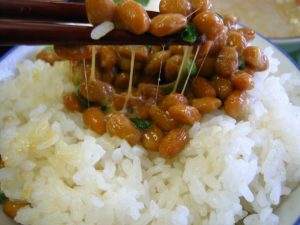
Natto on rice.
The natto, now traditional ingredient of the Japanese diet, is introduced in its 2 most common versions (itohiki-natto and shiokara-natto) during the Nara period by a Buddhist monk.Its consumption will be promoted by the progressive spread of Buddhist vegetarian practices.
The Japanese brought bing (bread) from China, a Chinese unleavened bread similar to French pancakes, following contacts with the Chinese dynasties Sui (581-618) and Tang (618-907)20. There is evidence that miso, hishio (the ancestor of soy sauce, a paste made from soy), and shi (soy nuggets) occupy a very important place in Japanese seasoning, part of the code Yōrō, a form of code regulating the life of ancient Japan being dedicated to them and stipulating how to use them. At the Imperial Court, Two Chiefs were responsible for the production of these three ingredients, which were also widespread among the Japanese people.
So it was a type of dairy product made in Japan between the 7th and 10th centuries. The method of preparing this dish is noted in Engishiki since the so could officially be used as a gift for the emperor. Daigo, another ancient Japanese dairy product, was made from soy.
Heian Period (794-1185)
The Heian period saw the appearance of chopsticks and the introduction of major dishes of Japanese cuisine, tofu and noodles. The codification of the rules of consumption is in progress : ceremonies or rituals related to sake are developed at the imperial court, and the osechi ryōri, which codifies banquets, appears. Originally reserved for ritual and religious uses, the chopsticks introduced from China at the same time as Confucianism began to be used for daily food and spread among the people, as evidenced by the development of the chopsticks trade in Japan.
In Japan, it is a popular tradition that tofu came from China, brought by the Buddhist monk Kanshin, in 754 AD or as in another version of the story, by the zen monk Ingen, who would have introduced it in 1654 AD. Instead of repeating the prevailing view, Shinoda Osamu undertook a study of ancient Japanese texts. The earliest records of tofu he identified can be found in an imperial menu dated 1183 AD and then in the letter of a monk dated 1239 AD.
From the 14th century onwards, the number of occurrences increased rapidly. Shinoda also notes that Buddhist temples have played an important role in the manufacture and dissemination of tofu. The obligation not to eat meat forced the monks to seek vegetarian and nourishing dishes as an alternative to animal protein.
So we can assume with Huang, that tofu probably came to Japan at the end of the Tang or under the Song. It was probably brought by buddhist monks at a time when cultural exchanges between the two countries were intense. It was also at this time that it was passed on to Korea. Japan’s tofu-making technique evolved differently than in China. Tofu is softer, lighter and has a finer flavour than in China.
Chinese noodles were introduced through Buddhist monks who imported them from The Song Dynasty (1127-1279) over a period from the end of the Heian period (1185) to the beginning of the Kamakura period (1185-1333).
The monks introduced all the cultivation linked to the production of flour, and objects that are intimately linked to it, such as the grindstone.A book, The Kyoka hitsuyo jirui zenshu, made around 1279, gives a list of recipes imported by one of these priests, Eisai (1141-1215), founder of the Rinzai School of zen Buddhism, namely: suikamen, sōmen, tettaimen, koshimen, suiromen and pasta called konton destined to be filled.
During the Heian period, sake was used in religious ceremonies, court festivals, and games in boire. The term ryōri refers to a type of meal, and by extension a type of cuisine to prepare it. The codification of osechi ryōri is defined for the first time: it is a banquet kitchen, with multiple dishes available to guests. It is the direct ancestor of the osechi served at the beginning of the Year in Japan.
Feudal period (1185-1603))
The feudal period saw the maturation of techniques for preparing ingredients, rites related to cooking and the codification of consumption patterns. Fermentation is mastered, cutting becomes an art, noodles in their present form appear, and honzen ryōri and shojin ryōri each define a particular meal style. Late in the day, Portuguese Jesuits introduce recipes that are adapted to local tastes and become a must in Japanese cuisine, such as tenpuras or tonkatsu.
Between the end of the Heian period and the beginning of the Kamakura period, the production of kōji, the fermentation source of most of the Japanese fermented products still in use today, was finally brought under control. Production can then become mass production and allows the diffusion of its products and facilitates access to them.
Udon noodles are first mentioned in a document, the Kagen-ki, on July 7, 1347, under the name uton. The first mention of soba noodles in Onryo-ken Nichiroku, October 12, 1438. The noodles known today in Japan are slightly different from these versions. The noodles will take their present form during the Eiroku era (1558-1570).
The first document referring to edamame dates back to 1275, when a famous Japanese monk, Nichiren, wrote a note thanking a parishioner for having left edamame on the temple. The edamame also appeared in haikai in the Edo period (1603-1868).
Honzen-ryōri (本膳料理) cuisine is considered to be reserved only for the Samurai. It is known ftom the time of Muromachi (1336-1573), it is considered to be the formal Japanese cuisine in the Edo period (1600-1868), but declined from the Meiji period (1868-1912). Today, it is found in a derivative form in the Kōchi region of Shikoku island, known as the sawachi cuisine (փփ, sawachi ryōri). Shojin ryōri is one of the three main types of food in modern Japan, consisting of strict adherence to vegetarian cuisine. Introduced to Japan around 531 AD, it is considered in the 13th century and adopted by a large number of Japanese people.
Instead of the narezushi ancestor, the Japanese preferred the namanare or the namanari. During the Muromachi period, namanare was the most popular type of sushi. Namanare was raw fish wrapped in rice, eaten fresh, before its taste deteriorated. Unlike the primitive narezushi, the namanare is a dish, and no longer just a method of preserving fish.
In medieval samurai society, the process of preparing poultry and meat begins to be ritualized. During the period (1394-1573), knife masters were recognized and the methods of preparation previously limited to cutting extended and codified the way of cutting, knives to use and developed into schools specializing in the tools and methods used.
The tempura recipe was introduced to Japan by Portuguese Jesuit missionaries active in Nagasaki during the 16th century (1549). These Jesuits also introduced panko and dishes that are still popular today, such as the tonkatsu.
All the dishes, resulting from this mixture of Portuguese and Japanese cuisine, are often referred to as “Nanban cuisine”.) (“barbarians of the south”) and is part of the various cultural contributions of this era referred to as Nanban art.
Edo Era (1603-1868)
The Edo period is the golden era of Japanese cuisine, finally coming to maturity [not neutral] . Economic prosperity and urbanization allow more and more people to consider cooking as a pleasure and an art.mirin plays an important role in Japanese cuisine, and the quintessence of traditional Japanese food, kaiseki ryōri is defined by merchants and artists. In the Edo period, mirin took its present important place in traditional recipes.
The diet of the Edo period resembles that of today’s Japanese, with some major exceptions, including the absence of meat and the rarer presence of Fish and seafood. It consisted of 3 meals, as it is today, and was based on the current menus, with a bowl of rice, a soup and one or two side dishes.There are numerous documents that make it possible to reconstruct the diet of the daimyos, which was differentiated between ordinary and ceremonial meals.
Ordinary meals usually consisted of rice, a soup, and one or two side dishes, as well as tsukemono. The sake was not served. The ceremonial meal, often in the evening, was a formal meal accompanied by a saké-tasting ritual, and potentially a drink party, and took place approximately once a week.The most common ingredients were rice, tofu, daikon, seasonal vegetables and mushrooms. The use of fish in regular menus varied from time to time (sometimes rarely present, sometimes more), with the exception of katsuobushi used as a seasoning; they were eaten more often at ceremonial meals.
Kaiseki kitchen.
Kaiseki cuisine (kaiseki ryōri) is that of merchants and artists. Its origin is confused with that of its namesake kaiseki ryōri of the tea ceremony.
After the 8th century narezushi and the medieval namare, a third type of sushi is introduced, the Haya-zushi. Haya-zushi was assembled in such a way that rice and fish could be eaten at the same time. Rice was no longer used for fermentation but mixed with vinegar, fish, vegetables and various dried ingredients. This type of sushi is still popular nowadays, each region has a local variation.
In the early 19th century, the yatai, small stalls selling food, became popular in Edo. It was at this time that the nigiri-zushi was created : consisting of a cluster of oblong rice surmounted by raw fish, it is the sushi known worldwide. After the Kantō earthquake of 1923, the leaders preparing the nigiri-sushi left Edo and dispersed across Japan, popularizing the dish across the country. Today, the world-famous sushi is the nigirizushi invented by Hanaya Yohei ( 1799-1858).
Introduction of foreign cuisine
In the early Meiji period (1868-1912), the sakoku (closure of the country) was abolished by Emperor Meiji and Western ideas and menus were considered the future of Japan. Among the reforms, the emperor lifted the ban on eating red meat, and promoted Western cuisine, which was seen as the cause of Westerners ‘ large size.
The transformation of Japanese food is twofold: on the one hand, foreign recipes and techniques are introduced, enlarging the palette of tastes of Japanese cuisine.
On the other hand, the lifting of the ban on eating meat increases the consumption of meat, milk and bread and leads to a decline in the consumption of rice, the intake of which is supplanted by animal protein. Recipes imported from the West and neighbouring countries have been adapted to local tastes and ingredients.
These adapted recipes are for the most part considered Japanese in the cultures from which they originate. Conversely, in Japan, they often remain outside traditional Japanese cuisine, even if they are part of the Japanese culinary heritage.
Japanese western cuisine, (yōshoku 洋食) refers to dishes that were imported from the West during the Meiji Restoration and adapted to local tastes. These are European dishes that have been adapted, which often have European sounding names, which are usually written using katakana. These are dishes most often based on meat, a new ingredient in Japanese cuisine, whose origins are European (French, English, Italian, etc.). These Japanese versions are often quite different from their original versions.
The opening of genuine European restaurants, serving versions more in keeping with their original recipes, made people aware of the difference between yōshoku and European dishes in the 1980s.
If you like European cuisine, you can also try some of the wonderfully delicious Croatian dishes and enjoy the diversity and rich flavors which Mediteranean cuisine offers.
Omurice, naporitan, korokke are examples of yoshoku dishes. Japanese curry was introduced to Japan during the same period, while India was under the administration of the English east India Company. This is why curry is classified in Japan as a Western dish instead of an Asian dish. During the same period, due to the opening of the country, many now popular dishes were imported from Chinese and Korean kitchens. If they followed the same import process, these dishes are not yōshoku since they are not Western. Among the most famous are the rāmen, the shabu-shabu and the gyoza. With these dishes, new cooking techniques appear, such as sauté cooking with wok, itamemono.
Decline in rice consumption
Under the influence of Western kitchens, meat, milk and bread are introduced into Japanese cuisine and Customs.Milk becomes a traditional ingredient in the diet of Japanese children. Before World War II, in 1939, rice was rationed at 330 grams of rice per day per person. The average consumption in the 2000s fell to 165 grams, with rice being replaced by meat. Between the 1960s and 2000, meat consumption increased by 400%, and by the mid-1980s, the ratio of meat to fish consumed reversed, with meat even exceeding fish consumption.

